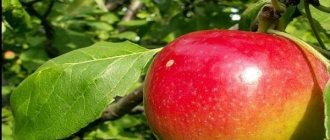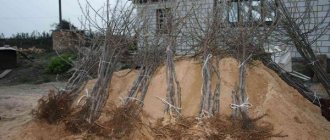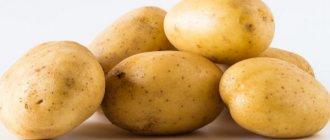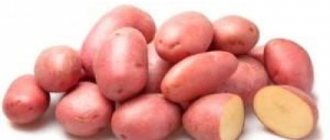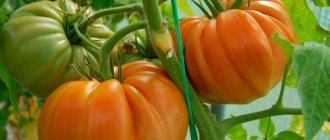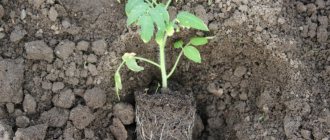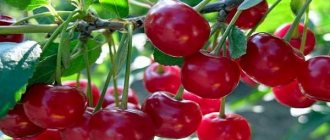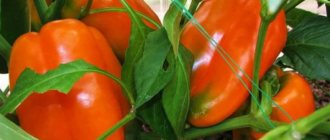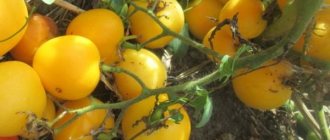What type does it belong to?
Cinnamon new is a very late autumn variety; rather, it can be considered an early winter one.
It is used in the central and North-Western regions of Russia and Belarus.
The variety is widespread both in industrial cultivation and in amateur garden plots.
Apples ripen at the end of September and are stored for about 2-3 months at temperatures from -1 to +1 C and air humidity of 95% . A cellar or cold basement is best suited for this purpose.
Whole, even, medium-sized apples are placed in wooden or plastic boxes and sprinkled with sawdust and straw.
These apples are used both for preparing compotes and juices, and for fresh use. The main disease during storage is wilting . They are distinguished by good transportability .
It is better to harvest the fruits at the beginning of their removable ripeness, then they are better stored and do not lose their external and taste properties.
Pollination of this variety requires attention, because... it is self-sterile and quite late . To obtain a good harvest, trees of early and late autumn ripening should be planted nearby.
Reviews on growing the Cinnamon Striped apple tree variety
A classic of domestic selection, the Brown Striped apple tree is found in almost every garden.
Red apples with amazing taste are different from other varieties. Therefore, when I received more than twenty years and began to develop a new plot, I decided to definitely plant an old variety of apple tree. I encountered a lack of fruiting in the first five years. I thought I bought the wrong variety. I began to study information on growing trees on the Internet and learned about some of the peculiarities of the variety’s agricultural technology, which I share with you in this article.
Description of the variety
The Cinnamon Striped apple tree, popular among Russian gardeners, has been cultivated in horticulture for more than two centuries. At the dawn of the 19th century, an unknown variety was described by the Tula landowner V. A. Levshin in agricultural works. Then it became known that nature itself created this variety, which earned recognition among gardeners.
The breeders saw in it good potential as a mother plant for crossing and were not mistaken. Over 15 new varieties have appeared thanks to Brown Striped.
Russian gardeners call the apple tree a variety of names: Cinnamon, Korichnevoe and Korichnevka. People named the tree so for the unique taste of the fruit pulp, which resembles cinnamon.
An adult tree with red apples has a rounded and lush crown. At a young age, the plant looks different - it grows upward, increasing its height. Plants grafted on a dwarf rootstock reach 4-5 meters in height and about 4 meters in width.
If the plant develops on a full-growing rootstock, mature trees grow up to 6 meters high. Accordingly, the crown size also increases to 5-6 meters.
Branches grow upward from the tree trunk. In summer, the crown is covered with dark green leaves with pubescent and rough leaf sides. In spring, pale pink flowers appear in mid-May. But to set fruit, pollination by insects and the location of other varieties of apple trees are necessary.
Brown striped is a self-sterile fruit crop, but attracts a large number of insects with nectar. Thanks to this, fruits are set on this and neighboring trees.
Important to remember! The older the tree, the more fruit it bears. A nearby apiary will increase the yield.
Tasters rated the taste at 4.75 - 4.88 points. The varieties obtained from Polosatoy surpassed the mother plant in some respects, including taste.
Variety varieties
Cinnamon New was bred by crossing Brown Tabby and Welsey. The fruits turned out to be larger in size and bear fruit later. At the end of September, a separately picked apple can reach 130 grams and will last all winter without spoiling.
The characteristics of the variety have improved:
- Increased immunity to scab and fungal infections.
- Resistance to frost has been maintained.
Pineapple has remained resistant to cold, but bears fruit only after a year. The fruits increased to 180 grams, a pineapple flavor appeared, which became the reason for scientists to call the variety Pineapple. The pulp has become more tender and the graininess has increased.
At the same time, keeping quality has decreased - apples are not stored for a long time. When ripe, it is better to pick them and immediately eat them or make preparations. If you leave apples on the branches, the taste will decrease.
Smoky (Sizoe) is another variety obtained from Polosatoy. It differs from the mother plant in a light matte coating that covers the blush. The photo shows the difference in appearance of the varieties. Smoky retained the properties of Striped.
All members of our family loved the variety for its juicy and tender pulp. When the harvest ripens, the apples sell out with a bang. The fruits do not linger. I like that the variety does not get sick and has an unpretentious disposition. The only drawback is that the harvest occurs once every two years. We have to wait patiently.
Marina, Moscow
At my dacha near Moscow there are 6 varieties of apple trees. Brown Striped is pleased with its high yield, which increases from year to year. True, we had to wait a long time for strong fruiting. After planting, the tree took 4-5 years to gain strength, but I was patient.
But now I couldn’t be happier. After all, the tree is not afraid of frost, and even in May, when there is frost, the flowers withstand the drop in temperature, compared to the sissies Melba and Idared. You have to put supports under the branches so that they don’t break off under the weight of the apples.
Of all the varieties of apple trees, Cinnamon Striped is most suitable for jam. It turns out to be amber in color and has an amazing taste. We eat apples fresh, and distribute the surplus to friends and family.
The Cinnamon Striped apple tree variety has been known in Russia since ancient times and was found in absolutely every garden. Today, it is undeservedly replaced by other varieties, but over time it has not lost its excellent taste.
It is believed that this type of apple tree appeared independently - as a result of mixed pollination by insects.
Based on it, scientists have developed about 20 more varieties of apple trees: Cinnamon New, Lungwort, Autumn Joy, Cypress, Aelita and others. The apple tree is common in the Central and Northern regions of Russia.
Description of the variety
The tree is very powerful and large, with a developed crown that grows in a pyramidal shape and then becomes rounded. The branches are elongated and thin. The foliage is located at the top of the tree.
Below it is almost naked. The leaves are dark green and elongated, slightly pubescent and rough. The edges are jagged.
In spring, white-pink flowers of medium size appear with medium-closed petals.
The persistent aroma emitted during flowering attracts pollinating insects. The shoots of the apple tree are smooth and dark brown in color. Fruits are formed precisely at the ends of the shoots, and not along the entire branch. The variety belongs to early autumn, so the fruits ripen in September, but the apple tree is not characterized by high yield.
Fruiting begins only from 6-8 years of age. At this time, the harvest is not yet stable and weak. Good results should be expected by the age of 10. The apple tree needs external pollination. Papirovka and Moscow Grushovka are excellent pollinators. This should be taken into account when planting a tree.
The main benefits of the Cinnamon Striped apple tree include:
- high frost resistance - the tree will withstand even severe cold (which even Antonovka and Anis cannot);
- external attractiveness of fruits;
- delicate aroma and unique taste of apples;
- long storage period: 2-3 months;
- easy adaptation to any conditions (apple trees grow and bear fruit equally in both the northern and southern regions of the country).
The disadvantages of the variety are:
- low yield and low weight of apples;
- fruiting only 6-8 years after planting the seedling;
- the slightest damage to the apple leads to its rapid spoilage;
- does not have immunity from scab and other diseases;
- requires a large area for growth, since the autumn crown is large.
It is also worth noting that during the period of heavy fruiting, branches may break off, so it is necessary to install supports.
Apples grow small (70-90 g), but can be larger (120 g). When unripe, they are light green in color, and by September the famous bright red stripes and specks appear. The peel is smooth and shiny, and the flesh is juicy and dense. The fruit tastes sweet, with a slight piquant sourness.
The fruits last for 2-3 months, so they are mostly consumed fresh. However, they make good jam, jam, and compote.
There is no need to plant the tree next to large plants or very close to the same “Browns”. Over time, the plant becomes wider, and crowding has an unfavorable effect on the life of the apple tree and the number of fruits.
The main condition is not to take sick or old plants, as well as seedlings that were grown in a warm climate. Usually “Korichnevka” is planted in the spring, in April, but it can also be planted in the fall, after the leaves have fallen.
Apple trees should be planted on well-moistened and drained soils, in a place that is not blown by strong winds. The best soil option is loamy, suspended and leached chernozem. Acidity – neutral.
- In a well-lit area, dig a hole the size of the root system of the seedling, and pour several kilograms of horse humus onto the bottom.
- Then the seedling is buried and watered.
At first the tree grows upward, so many gardeners plant other plants close to the apple tree. But this cannot be done, because in a few years the seedling will expand to the sides, and the close proximity will interfere with it. Because of this, Cinnamon Stripe is better suited for large areas than small ones.
If the planting conditions are incorrect, the plant often requires replanting and choosing a better place to grow. This may be a place with more light or less wind.
Feeding
In the spring, the tree should be fed with nitrogenous fertilizers for intensive growth of shoots and roots, and in the fall with phosphorus-potassium fertilizers so that the seedlings survive the winter more easily. You should know when to stop and not overfeed the plants - this greatly affects the yield.
It is highly undesirable to plant apple trees close to groundwater. This may affect the quantity and frequency of fruiting.
Description of the variety Cinnamon new
What does the Cinnamon new apple tree and its fruits look like?
The tree is very tall with a broom-shaped crown at a young age and more rounded and lush at maturity.
The main branches grow at a fairly acute angle to the trunk. The bark on the trunk is dark brown, brown.
The shoots are quite leafy and thick.
The leaves are medium to large, oval with a pointed, uneven base.
The petioles are small, thick, the buds are small.
Find out about other autumn varieties of apple trees: Uslada, Uspenskoye, Kutuzovets, Pepin Shafranny, Flashlight, Solnyshko, Uralskoye Nalivnoye, Skala, Freshness, Screen, Yantar, Uralets, Lyubava.
The fruits are quite large, smooth, and uniform in size . The skin is dense, yellowish with red spots and dark stripes. The apple is sweet and sour, juicy. The pulp is dessert, creamy-pink in color with a hint of cinnamon.
Reviews
The most frost-resistant apple tree. The advantages are the excellent taste of the fruit, harmonious in sugar and acidity, aromatic, the apples are small in size but beautiful.
Delicious apples, excellent frost and drought resistance. For me, the downside is that the apples are a little small, but this is not an intensive variety, quite unpretentious, so you shouldn’t expect large fruits. Early fruiting is low - 10-15 years, but on semi-dwarf rootstocks - 5-6 years. Usually seedlings are sold grafted on modern low-growing rootstocks, so this is no longer a big problem.
Of the advantages of Cinnamon, I can only say about its unsurpassed winter hardiness. Otherwise I don't like the apple. Now there are many modern varieties that have many times higher yields and are not inferior in taste. Suitable for summer residents who are rarely at the dacha and do not particularly care for the garden.
Photo
History of selection
The Cinnamon new variety was bred by S.I. Isaev at the All-Russian Research Institute of Horticulture named after. Michurina as a result of crossing the Cinnamon Striped with Welsey . The result is a variety that has the best qualities of the parent varieties.
The advantages of New Cinnamon include: good winter hardiness of the tree, resistance to scab and powdery mildew, excellent taste, uniform fruit size.
Among the disadvantages: slow increase in yield and late entry into fruiting, fruits do not appear every year and do not have a very long shelf life.
Pros and cons of the variety
Most varieties of apple trees have their strengths and weaknesses, and New Cinnamon is no exception. The advantages of the plant include:
- resistance to low temperatures, thanks to which apple trees grow well in cold climates;
- taste qualities that allow you to prepare delicious compote or jam from ripened fruits;
- high degree of adaptation to climate change.
Among the disadvantages are the following:
- Late onset of fruiting. Harvesting occurs no earlier than seven years after planting.
- Susceptibility to mechanical damage. The fruits are covered with a thin peel, which is unable to reliably protect the apple pulp when dropped.
See also
Description and characteristics, pros and cons of the Quinti apple tree variety and growing featuresRead
Productivity
Cinnamon new begins to bear fruit quite late, 6-8 years after planting . In young trees, the yield is small and increases slowly.
At the age of 18-20 years, the yield can be about 250-320 c/ha . At the same age, fruiting occurs every year. The tree's great height can make harvesting difficult.
The following apple tree varieties have high yields: Antey, Malinovka, Kuibyshevskoe, Daughter Pepinchik, Yablochny Spas, Phoenix Altaisky, Belyi Naliv, Lobo, Gala, Papirovka, Winter Grushovka, Dessert Antonovka, Stroevskoe.
Ripening and fruiting
The variety is not fast-growing. The first fruits can be collected only after 6 years. For several years, the yield will only increase; there will be little fruit.
Mature apple trees produce about 300 kg of harvest. This indicator continues for about 20 years, then the yield becomes periodic, every other year.
New Cinnamon is harvested at the end of September. Although the apples stick tightly to the branches, it is better to harvest them at the initial stage of ripening. This will give you a longer shelf life.
The photo shows a new harvest from one Cinnamon apple tree.
Planting and care
To get a good harvest, you need to properly plant and care for the apple tree. Then the harvest will please you.
Forest, sandy, loamy and turf soils are suitable for apple trees . Apple trees feel better on small, well-ventilated slopes.
Be sure to carry out preparation, soil cultivation and liming.
Planting can be done both in spring and autumn.
But in the spring you need to meet the period from the melting of the snow to the swelling of the buds. Autumn planting is carried out in October, 15-20 days before real frosts.
Planting pits are prepared in advance.
The depth and width of the hole may depend on the depth of groundwater.
On average 50-70 cm . diameter and about 1-1.5 m . depth.
A stake 8-10 cm long is driven into the finished hole . below the seedling, the dug layer of soil mixed with humus is filled in.
Mineral fertilizers are added. When the fertilizers have settled, planting begins.
The seedling is placed close to the peg, on the north side. In this case, the root collar should protrude 5-8 cm from the soil.
The roots are carefully straightened and covered with soil.
After planting, the hole is watered abundantly and mulched. The seedling is connected to the peg using loosely tied twine. After 3-4 weeks, bandage it tighter.
The first feeding can be done with a growth stimulator 2 weeks after planting. It is advisable to cover young seedlings for the winter.
In the first year of life, the seedling is fed several times: in the spring, nitrogen root feeding is carried out, and in the summer - 2-3 foliar feedings.
For foliar feeding, special liquid fertilizers are used and carried out every 2 weeks. Subsequently, before fruiting begins, nitrogen root feeding is carried out in the spring and potassium-phosphorus feeding in the fall.
It is imperative to weed and loosen the tree trunk.
Fruit-bearing trees are fed 3-4 times a year.
The first feeding is carried out in early May, the second - at the beginning of flowering, the third - during the period of fruit filling and the fourth - after harvesting.
Fertilizing is done with root, organic and mineral fertilizers.
Before fertilizing, good watering is necessary . After applying fertilizers, water the soil generously again. You can also use foliar fertilizing with special mineral fertilizers.
For proper development of the apple tree, regular pruning is necessary.
The first pruning is formative. It is carried out in the first year after planting.
3-4 years after the first pruning, annual pruning is carried out for normal crown formation. Rejuvenating pruning is carried out on old trees in order to remove dried or diseased branches.
Don’t forget about regular watering and whitewashing the trunks with lime mortar to protect them from pests.
Watch a video about what care an apple tree needs in the fall.
Diseases and harmful insects
Thanks to its excellent immunity, the Cinnamon New apple tree variety is extremely rarely affected by scab and fungal infections, but not a single fruit tree is immune from the appearance of harmful insects. If the rules of care are not followed and there is no prevention, you can expect to encounter sawflies and codling moths, flower beetles and various types of aphids and moths. During the ripening period, pests cannot be controlled using chemicals, so you must carefully care for the tree to avoid the appearance of parasites. The crown of the tree and the area around the tree trunk can be treated in the spring before flowering and in the fall, after leaf fall. Dried and damaged branches, fallen leaves and old bark must be burned, the area around the tree trunk must be weeded and loosened. In spring and autumn, the trunk should be whitened; this will not only protect the tree from pests, but also from burns in the spring and from frost in winter.
